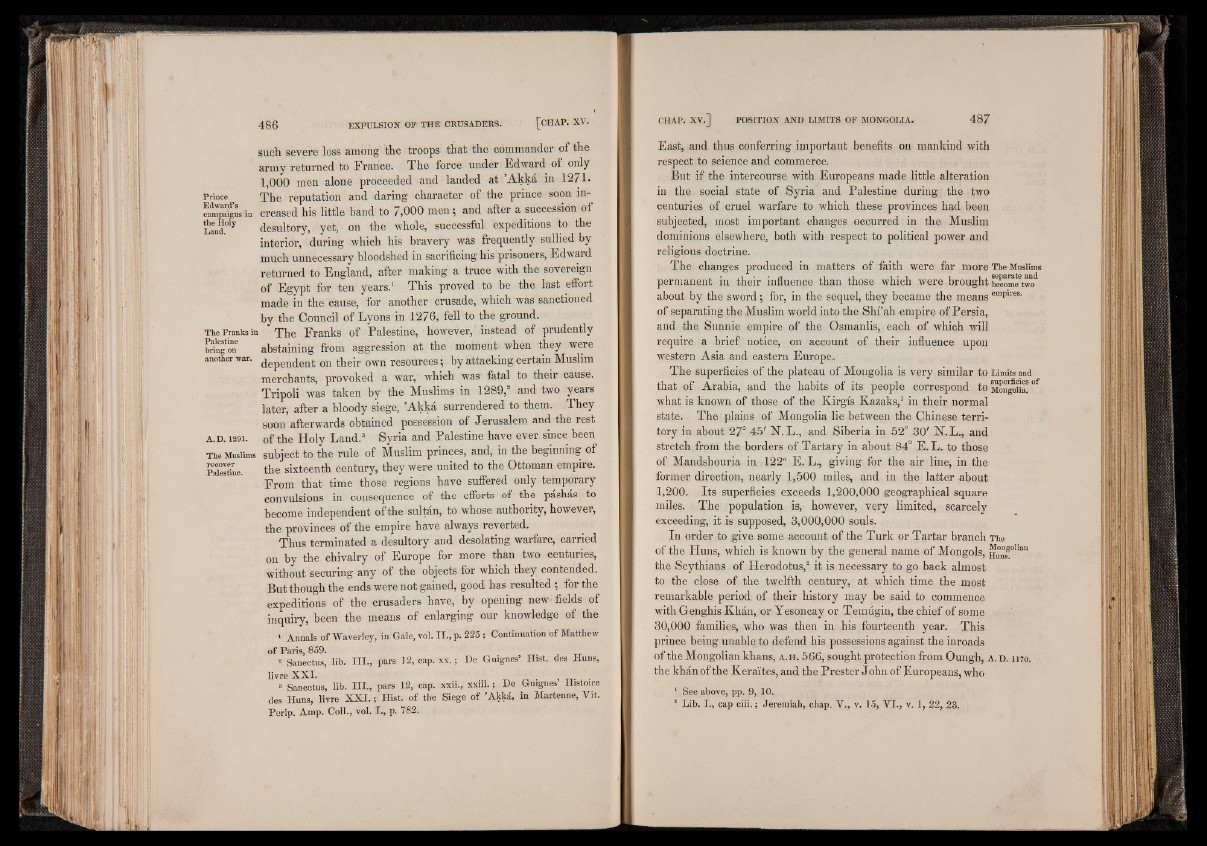
such severe loss among the troops that the commander of the
army returned to France. The force under Edward of only
1,000 men alone proceeded and landed at ’Akká in 1271-
Prince The reputation and daring character of the prince soon incampaigns
in creased his little band to 7,000 men; and after a succession of
L¿,d.°ly desultory, yet, on the whole, successful expeditions to the
interior, during which his bravery was frequently sullied by
much unnecessary bloodshed in sacrificing his prisoners, Edward
returned to England, after making a truce with the sovereign
of Egypt for ten years.1 This proved to be the last effort
made in the cause, for another crusade, which was sanctioned
by the Council of Lyons in 1276, fell to the ground.
The Franks in The Franks of Palestine, however, instead of prudently
Mngon abstaining from aggression at the moment when they were
another -war. ¿epen¿ent; on their own resources; by attacking certain Muslim
merchants, provoked a war, which was fatal to their cause.
Tripoli was taken by the Muslims in 1289,2 and two years
later, after a bloody siege, ’Akká surrendered to them. They
soon afterwards obtained possession of Jerusalem and the rest
a .d . 1291. of the Holy Land.3 Syria and Palestine have ever since been
The Muslims subject to the rule of Muslim princes, and, in the beginning of
■ S the sixteenth century, they were united to the Ottoman empire.
From that time those regions have suffered only temporary
convulsions in consequence of the efforts of the páshás to
become independent of the sultán, to whose authority, however,
the provinces of the empire have always reverted.
Thus terminated a desultory and desolating warfare, carried
on by the chivalry of Europe for more than two centuries,
without securing any of the objects for which they contended.
But though the ends were not gained, good has resulted ; for the
expeditions of the crusaders have, by opening new fields of
inquiry, been the means of enlarging our knowledge of the
1 Annals of Waverley, in Gale, vol. I I ., p. 225 ; Continuation of Matthew
o f Paris, 859. '
2 Sanectus, lib. I I I . , pars 12, cap. x x .; De Guignes’ Hist, des Huns,
livre X X I . .
* Sanectus, lib. H I ., pars 12, cap. xxii., x x iii.; De Guignes Histoire
des Huns, livre X X I . ; Hist, of the Siege of ’Akká, in Martenne, Vit.
Perip. Amp. Coll., vol. I., p. 782.
East, and thus conferring important benefits on mankind with
respect to science and Commerce.
But if the intercourse with Europeans made little alteration
in the social state of Syria and Palestine during the two
centuries of cruel warfare to which these provinces had been
subjected, most important changes occurred in the Muslim
dominions elsewhere, both with respect to political power and
religious doctrine.
The changes produced in matters of faith were far more The Muslims
permanent in their influence than those which were broughtbecometwod
about by the sword; for, in the sequel, they became the means empn’es'
of separating the Muslim world into the Shi’ah empire of Persia,
and the Sunnie empire of the Osmanlis, each of which will
require a brief notice, on account of their influence upon
western Asia and eastern Europe.
The superficies of the plateau of Mongolia is very similar to Limits and
that of Arabia, and the habits of its people correspond to Mongolia? °f
what is known of those of the Kirgis Kazaks,1 in their normal
state. The plains of Mongolia lie between the Chinese territory
in about 27° 45' 1ST. L., and Siberia in 52° 30' N.L., and
stretch from the borders of Tartary in about 84° E. L. to those
of Mandshouria in 122°1E. L., giving for the air line, in the
former direction, nearly 1,500 miles, and in the latter about
1,200. Its superficies exceeds 1,200,000 geographical square
miles. The population is, however, very limited, scarcely
exceeding, it is supposed, 3,000,000 souls.
In order to give some account of the Turk or Tartar branch The
of the Huns, which is known by the general name of Mongols, g “ go1“
the Scythians of Herodotus,2 it is necessary to go back almost
to the close of the twelfth century, at which time the most
remarkable period of their history may be said to commence
with Genghis Khan, or Yesoncay or Temugin, the chief of some
30,000 families, who was then in his fourteenth year. This
prince being unable to defend his possessions against the inroads
of the Mongolian khans, a . h . 566, sought protection from Oungh, A. d . 1 1 7 0 .
the khan of the Kera'ites, and the Prester John of Europeans, who
1 See above, pp. 9, 10.
8 Lib. I., cap c iii.; Jeremiah, chap. V., v. 15, V I., v . 1, 22, 23.